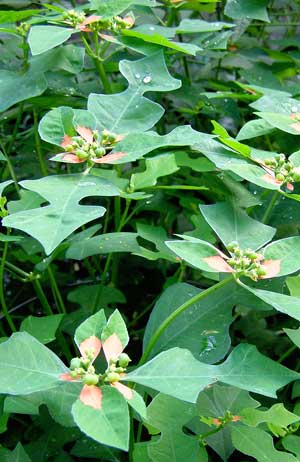
By Ken Moore
Flora Columnist
Several weeks ago, Raleigh friend Margaret Schucker emailed to me a plant image with this inquiry: “What is this? I found it growing out of a crack in the sidewalk and came home and threw it into the ground. It looks sort of like a poinsettia, but obviously not on steroids. If it’s not some kind of horrible, invasive thing, I will leave it there. It’s great to have anything that blooms in this heat. Plus I didn’t have to do anything to help it along. Good quality in a plant!â€
For several weeks, I’ve been enjoying wild poinsettia, Euphorbia cyathophora, formerly E. heterophylla, beneath my seashore mallows. I had considered describing this unusual waif of a plant to Flora readers, but other plants kept pushing it aside.
Having one make its way to Margaret’s yard was enough to bring it forth for this week.
This smallish, native annual is also called fire-on-the-mountain and painted leaf, definitely descriptive names.
My original plants came from the members’ plant sharing at an N.C. Native Plant Society annual picnic several years ago. Keen plantsman Pete Schubert brought seedlings from his Durham garden, where they had proliferated from ones he dug from the garden of exceptional plantswoman Edith Eddleman. I treasure such pass-along plants because they all come with stories shared by special friends.
In past years, I’ve delighted in spotting these dwarf poinsettias scattered sparingly about the yard. This year, I have a patch making quite a statement because I have been watering them during the drought. Those little waifs are standing 3 feet tall, making a commanding mass below the mallows. Others scattered about elsewhere are barely a foot tall, but are still showing cheerful red-tinged leaves in spite of no watering.
In North Carolina, this plant is scattered in the Piedmont and coastal plain; its original range is obscure. It’s considered native to the lower South down into tropical America. In some distant countries like Brazil and India, it is a “horrible invasive†in agricultural crops.
Alerted by descriptions of its invasive nature, I checked with my friend and invasives guru Johnny Randall at the Botanical Garden. His response, “For all practical purposes, this subtropical weed is a ‘waif’ for us in the Piedmont and has little chance of posing a threat to natural area ecology,†made me relax.
If you happen to spot this little poinsettia in your garden or while walking out and about, take a “closer look.†You will discover that, like the showy-specimen poinsettias of the holidays, those red petals are really leaves, modified to mimic petals. The true flowers are those little bud-like structures in the middle, out of which you may see heart-shaped balls that are the developing fruit extending out from within the cup-like flowers, all of which are characteristics of the Euphorbia plant family.
I hope you are fortunate to spot this little cousin of the Christmas poinsettia. You can imagine yourself having to grab for a sweater before you walk outdoors.
Email Ken Moore at flora@carrborocitizen.com.


